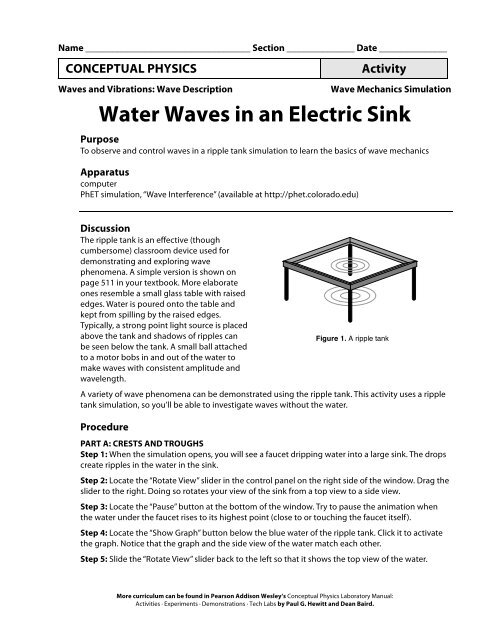Waves in Electric Sink.pdf - PhET
Waves in Electric Sink.pdf - PhET Waves in Electric Sink.pdf - PhET
- Page 2 and 3: a. In the spaces below, sketch the
- Page 4 and 5: More curriculum can be found in Pea
a. In the spaces below, sketch the wave pattern as seen from the top and from the side.Side View (Graph)Top Viewb. In both views (side view and top view), label a crest and a trough.c. In both views, label one wavelength.PART B: AMPLITUDEStep 1: Pause the animation. Locate the frequency slider below the faucet. Set the frequency to itsmaximum value by mov<strong>in</strong>g the slider all the way to the right. Restart the animation by click<strong>in</strong>g theon-screen “Play” button.Step 2: Locate the amplitude slider. Slide it to various positions (to the left and right) and observethe effect this has on the simulation.a. Does a change <strong>in</strong> amplitude result <strong>in</strong> a change <strong>in</strong> the size of the water drops? If so, how?b. How are high-amplitude waves different from low-amplitude waves?c. Review your sketches above (side view and top view) of the wave. Label the amplitude of thewave.d. Which view—side or top—is better suited for label<strong>in</strong>g the amplitude? Expla<strong>in</strong>?e. What—if anyth<strong>in</strong>g—happens to the amplitude of each wave as it gets farther away from thesource?More curriculum can be found <strong>in</strong> Pearson Addison Wesley‘s Conceptual Physics Laboratory Manual:Activities · Experiments · Demonstrations · Tech Labs by Paul G. Hewitt and Dean Baird.
PART C: FREQUENCYStep 1: Pause the animation. Set the amplitude to its maximum value by mov<strong>in</strong>g the slider all theway to the right. Restart the animation by click<strong>in</strong>g the on-screen “Play” button.Step 2: Move the frequency slider to various positions (to the left and right) and observe the effectthis has on the simulation.a. How are high-frequency waves different from low-frequency waves? (What is different?)b. How are high-frequency waves the same as low-frequency waves? (What isn’t different?)c. Two students disagree about an observed difference between high-frequency waves and lowfrequencywaves. One says high-frequency waves are faster than low-frequency waves; the otherclaims both waves have the same speed. What do you th<strong>in</strong>k?d. What is the relationship between the frequency (f ) of the wave source (the dripp<strong>in</strong>g faucet)and the wavelength (λ of the waves?__ Direct proportionality: λ ~ f. The wavelength <strong>in</strong>creases as the frequency <strong>in</strong>creases.__ Inverse proportionality: λ ~ 1/f. The wavelength <strong>in</strong>creases as the frequency decreases.__ No apparent relationship. The wavelength doesn’t appear to be related to the frequency.e. What—if anyth<strong>in</strong>g—happens to the frequency of each wave as it gets farther away from thesource?Summ<strong>in</strong>g Up1. Exam<strong>in</strong>e the illustrations below. Each represents a ripple tank wave. Some are side views; someare top views. Describe the amplitude of the wave and the frequency of its source by us<strong>in</strong>g theterms “high” or “low.” Please exam<strong>in</strong>e all the patterns before record<strong>in</strong>g your descriptions. (H<strong>in</strong>t:<strong>Waves</strong> a–d are all different from one another.)a. _______________amplitude_________________ frequencyMore curriculum can be found <strong>in</strong> Pearson Addison Wesley‘s Conceptual Physics Laboratory Manual:Activities · Experiments · Demonstrations · Tech Labs by Paul G. Hewitt and Dean Baird.
More curriculum can be found <strong>in</strong> Pearson Addison Wesley‘s Conceptual Physics Laboratory Manual:Activities · Experiments · Demonstrations · Tech Labs by Paul G. Hewitt and Dean Baird.
. _______________amplitude_________________ frequencyc. _______________amplitude_________________ frequencyd. _______________amplitude_________________ frequency2. What s<strong>in</strong>gle aspect of a wave does its amplitude best represent?___ speed ___ wavelength ___ frequency ___ energy ___ period3. a. Which control on a music player or television set allows you to <strong>in</strong>crease or decrease theamplitude of the sound waves that come out of it?Recall what happens to the amplitude of a wave as the wave gets farther from the source.Imag<strong>in</strong>e a portable music player play<strong>in</strong>g music <strong>in</strong> a large, open field. At some distance from theplayer, the amplitude of the sound waves dim<strong>in</strong>ishes to zero, and the sound cannot be heard.Consider the 3-dimensional space <strong>in</strong> which the sound can be heard.b. How might you <strong>in</strong>crease that space, and what is 3-dimensional space called (<strong>in</strong> geometry)?c. Ripple tanks are used to observe 2-dimensional waves. What should be the name of theamplitude control for 2-dimensional waves?More curriculum can be found <strong>in</strong> Pearson Addison Wesley‘s Conceptual Physics Laboratory Manual:Activities · Experiments · Demonstrations · Tech Labs by Paul G. Hewitt and Dean Baird.



